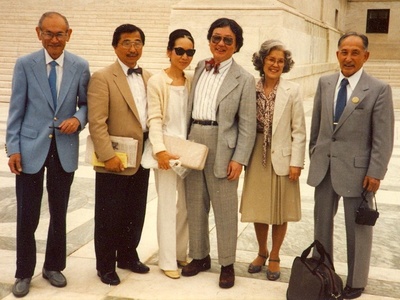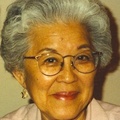Naive housewife evolves as concerned citizen and political activist
It was when my daughter Lisa was in high school, during the turbulent years of the Vietnam war and simultaneous demands for civil rights and social justice at home, that I began to think of words that reflected puzzling contradictions between events as they actually happened versus the words that were used to describe them. We discussed the current news and read of U.S. military press officers trying to explain the destruction of villages and the death of civilians with statements, such as “They were communists, and we had to destroy the village in order to save them from communism....” Other news reported sheriffs’ deputies in cities of the American South using heavy batons and fire hoses against men, women, and children who were peacefully demonstrating for voting rights, fair housing, and an end to racial segregation.
I found myself hard-pressed to satisfactorily explain to my daughter, let alone myself, the stark contradictions between what we had been taught about American values and American democracy versus the stark realities carried into our home by the news. I had naively accepted the dictum that we lived in a society based on the rule of law, but it was increasingly clear that laws were not synonymous with justice and fairness. Duplicity, betrayal and hypocrisy were more apt descriptions for a society whose laws were explicitly racist and sexist. Talk of what had happened to over 120,000 Nikkei during World War II was not a part of dinner conversation in many Nikkei families, where Nisei parents largely or mostly suppressed any mention of the wartime incarceration. Thus many Sansei (third generation Nikkei) did not learn that coded references to life in “camp” by parents, uncles and aunts were really about their lives as political prisoners in concentration camps unless they read watered down or distorted versions about it in university political science and history courses. Unfortunately, the wartime Nikkei experience was not a part of classroom teaching and learning materials at all levels of instruction across the nation until relatively recently.
During those difficult talks with my teenage daughter over the dinner table, it became increasingly clear that I had to confront stark and painful memories that I had long suppressed and denied. Like many other members of the Nisei generation, despite having been forced into compliance with government powers, I had survived the trauma of our mass expulsion and imprisonment during World War II. Some survivors of the concentration camps were not as fortunate as their experience led them to play out their trauma often through domestic violence, addiction to alcohol, and other anti-social behavior. After our release at war’s end, we struggled to survive and slowly reconstructed our lives by sheer hard work and a fatalistic attitude summed up by the Japanese phrases “shikataganai” (there is no recourse, you can’t change it) and “gaman” (endure with patience).
The anti-war and social justice demonstrations of the 1960s led a conservative writer to describe Japanese-Americans as a hard-working, self-reliant, and politically docile “model minority”– unlike more militant ethnics and feminists.1 Many Nisei were seduced by such backhanded praise and carefully steered clear of political activism and public controversy, lest it upset white employers and neighbors. I behaved like many other politically naive Nisei who strove to fit perfectly the “model minority” stereotype. But the sixties and seventies changed all that forever.
The more I watched the brutal suppression of peaceful protest movements the more I realized that I had personally experienced discrimination in many ways: rejected by landlords and employers who “did not want Japs,” refused my high school diploma by a racist principal, coerced to use “Louise” instead of my real first name which many non-Japanese found difficult to remember--the list of daily humiliations was long. Gradually I developed a sense of righteous indignation and outrage about social injustices experienced by many groups in the U.S., and I began to seek out events and organizations to learn more and become involved in political change. After the war I had moved to New York, where eventually a small but sophisticated and politically active Nikkei enclave had evolved.2 I joined a group called Asian Americans for Action (AAA), one of the first such ethnic political organizations on the East Coast. The group included Bill and Yuri Kochiyama, Shizu “Minn” Matsuda, the Iijima family–Kazu, Tak and Chris--Mitzi Sawada, June Kushino, Chiyeko Watanabe, and other like-minded political activists. I joined them in demonstrations about social injustice, economic and political issues at home and abroad.
In 1976 when her seminal work, Years of Infamy: The Untold Story of America’s Concentration Camps, was published, I met the extraordinary Michi Nishiura Weglyn, a costume designer for television programs. Evidence she discovered through her meticulous research revealed previously unknown facts that refuted the claim of “military necessity” for Executive Order 9066 and the vast gulag of concentration camps that ensued. Her book made me acutely aware of the grave injustice of the dispersion, exile, and imprisonment of Nikkei from the West Coast.

Fred Korematsu, Gordon Hirabayashi, Michi Weglyn, William Hohri, Aiko Herzig-Yoshinaga, and Harry Ueno in front of the Supreme Court in Washington, D.C. (Photo taken by Jack Herzig)
Marriage to Jack Herzig, a former U.S. Army lieutenant colonel paratrooper, moved me to a home in Virginia conveniently located about 20 minutes from the National Archives (NA) in Washington, D.C. My initial interest in going to the NA was to find records concerning my own family in the concentration camps, but Michi cajoled and encouraged me to pursue an ever-expanding variety of issues related to the wartime exclusion history. NA archivists were delighted to see my interest and were generous in help and advice. Michi’s relentless pursuit of the long-concealed truth inspired me to travel to other sites with Jack, who had joined me in the search for truth. We visited institutions where official records and private collections were accessioned, including the Franklin D. Roosevelt Library in Hyde Park, New York; the George C. Marshall Library in Lexington, Kentucky; California branches of the NA in San Bruno and Laguna Niguel; the Bancroft Library at the University of California, Berkeley; the Hoover Institution at Stanford, California, and other repositories. During this process my attention was drawn increasingly to the arcane euphemisms employed by officials, scholars, and journalists that obscured or distorted what was really going on.
Jack joined me as a fulltime, enthusiastic research partner after his retirement. As a career soldier for a good part of his life, he had fought during WW II on the front lines in the Pacific Theater to secure the liberty and freedoms of Americans while at the very same time--he learned through the research in which we were engaged--our government was denying its own citizens their constitutional rights and benefits by uprooting and incarcerating them. For himself and for the many very close trooper friends who lost their lives during World War II, he felt very betrayed by his own country. Jack was outraged by the injustice caused to an innocent racial minority through the promulgation of Executive Order 9066. His experiences in the Army not only as a combat soldier but also in intelligence gathering and evaluation served the CWRIC well as the commission was able to call upon him as a consultant when necessary in connection with War Department documents.
Researcher for the Commission on Wartime Relocation and Internment of Civilians.
By the time I applied for a position in 1981 as a researcher for the newly-created Commission on Wartime Relocation and Internment of Citizens (CWRIC), I had accumulated approximately 8,000 documents relating to the subject that served as the basis for the commission’s investigation. Jack and I reviewed thousands of documents from the War Relocation Authority and War Department records, as well as other federal agencies. I utilized the 3 x 5 index card catalog system by cataloguing every document added to the collection for study by the commission. These may have been a memo, letter, cablegram, report, telephone transcript, directive, table/chart or some other form of communication. I wrote a brief summary of major points of each document and assigned a CWRIC number to it, including the citation or source from which I had retrieved it.
These efforts assisted the National Council for Japanese American Redress (NCJAR) which filed a class action lawsuit, William Hohri, et al., v. U.S.A., on behalf of the prisoners.3 The Supreme Court denied a hearing of the complaint on a technicality.
In another judicial action, Jack and I joined the legal teams in the search for documentary evidence for the writ of coram nobis petitions in three separate wartime cases, those filed in the names of Fred Y. Korematsu, Gordon K. Hirabayashi, and Minoru Yasui. In 1942 these men had sought to challenge the constitutionality of the mass removal and incarceration. Evidence was discovered that federal officials had committed perjury before the wartime Supreme Court in these cases and that the government had falsified, suppressed, altered, and destroyed critical evidence “that could have persuaded the Supreme Court to strike down” the massive exclusion and incarceration. These revelations provided the legal basis Japanese Americans needed to seek redress and restitution for their wartime imprisonment.4
Soon after I began working with the CWRIC, I began to compile a list of terms that I tentatively named a “Work in Progress—Not for Publication.” Over the years a fuller descriptive subtitle evolved: “Terminology: WW II Exclusion/Incarceration of West Coast Japanese Americans.” Now it is called “Words Can Lie Or Clarify: Terminology of the World War II Incarceration of Japanese Americans.”
Notes:
1. William Peterson. “Success Story: Japanese American Style,” New York Times (January 9, 1966): “By any criterion of good citizenship that we choose, the Japanese Americans are better than any group in our society, including native-born whites....”
2. For the origin and evolution of the Nikkei community in New York City, see: Mitziko Sawada. Tokyo Life, New York Dreams: Urban Japanese Visions of America, 1890-1924 (Berkeley, California: University of California Press, 1996), 268 pp.
3. Thomas Fujita-Rony. “‘Destructive Force’: Aiko Herzig-Yoshinaga’s Gendered Labor in the Japanese-American Redress Movement.” Frontiers (XXIV:1, 2003), 38-60: “This article explores the labor of...activist Aiko Herzig-Yoshinaga.... Her discovery of previously unknown factual evidence and...her ability to recreate and document the ‘paper trail’...for others prompted one opposing lawyer to call her a ‘destructive force’.” (p. 38).
4. Peter Irons. Justice At War: The Story of the Japanese American Internment Cases (New York: Oxford University Press, 1983).
*Note: This essay has circulated over the past decade among friends and research associates with the working title “Work in Progress: Terminology – WW II exclusion/incarceration of West Coast Japanese-Americans.” Copyright © 2009. Rev. 2010.
© 2009 Aiko Herzig-Yoshinaga



